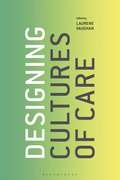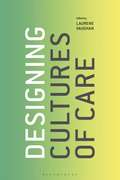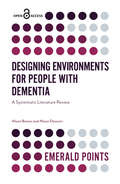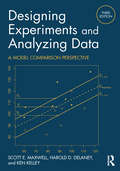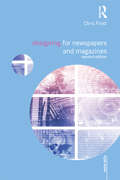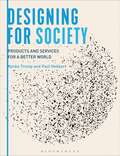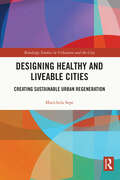- Table View
- List View
Designethnografie: Methodologie und Praxisbeispiele
by Francis MüllerDas Lehrbuch entwickelt Methoden für die Designrecherche, denn Designen erfordert und erzeugt zugleich Wissen, was in der Praxis oftmals intuitiv passiert. Wird die Erzeugung dieses Wissens jedoch methodisch geleitet und reflektiert, dann stärkt dies die Designdisziplin und begünstigt ihre interdisziplinäre Vernetzung. Die Ethnografie ist hierzu eine geeignete Methode: Designethnografie bedeutet, dass eine Designerin in eine soziale Lebenswelt eintaucht, dort bestimmte Wirklichkeitsausschnitte beobachtet, analysiert und sie verändert – zum Beispiel mit Intervention und partizipativen Ansätzen. Werden solche Verfahren dokumentiert und theoretisch reflektiert, dann werden designspezifische Erkenntnismodi sichtbar.Der Inhalt• Der blinde Fleck• Alltagswelt und Intersubjektivität• Designforschung: Immersion und Intervention• Abduktion: kartographierte Entdeckungsreisen• Methoden und Aspekte der Feldforschung• Analyse• Darstellen und Berichten• Transfer ins Design• PraxisbeispieleDie ZielgruppenStudierende und Dozierende des Designs und anderer Disziplinen, in denen ethnografisch recherchiert wirdStudierende und Dozierende der Kulturanthropologie und -soziologieDer AutorFrancis Müller ist Dozent für Ethnografie und Kulturanthropologie in der Fachrichtung „Trends & Identity“ im Departement Design an der Zürcher Hochschule der Künste. Er hat Lehraufträge an den Universitäten St. Gallen (HSG), Liechtenstein und Iberoamericana in Mexiko-Stadt, wo er auch im Editorial Board des Journals DIS vertreten ist.
Designing And Conducting Mixed Methods Research (PDF)
by John Creswell Vicki L. Plano ClarkCombining the latest thinking in the field with practical, step-by-step guidance, the Third Edition of John W. Creswell and Vicki L. Plano Clark's Designing and Conducting Mixed Methods Research now covers seven mixed methods designs with accompanying journal articles illustrating each design. The authors walk readers through the entire research process, and present updated examples from published mixed methods studies drawn from multiple disciplines. In addition, this new edition includes information about the dynamic and evolving nature of the field of mixed methods research, four additional methodological approaches, and coverage of new directions in mixed methods.
Designing and Conducting Research in Social Science, Health and Social Care
by Fiona Mcsweeney Dave WilliamsThis book presents a novel and accessible way to learn about designing and conducting social research. Unlike traditional social research methods books, it provides a ‘real world’ account of social researchers’ experiences and learning achieved through conducting research in a variety of fields. It contains an eclectic collection of research and advice for conducting research from social researchers with varying backgrounds. Suggestions are made in relation to gaining access to research sites, conducting research on sensitive topics such as suicide, child sexual abuse and homelessness, ensuring the inclusive participation of participants with intellectual disabilities and children. Also included are discussions of conducting practitioner research, conducting research on individual change, psychoanalytically informed research, documentary research and post qualitative research. Other chapters focus on criticality in research on topics that have become politicised and moralised, ensuring that research conducted is credible and how knowledge in research is constructed through both the theoretical framework used and how it is conducted. Bringing together a diverse collection of social research projects, Designing and Conducting Research in Social Science, Health and Social Care will be of interest to students, educators and researchers in the social sciences and professionals in related areas.
Designing and Conducting Research in Social Science, Health and Social Care
This book presents a novel and accessible way to learn about designing and conducting social research. Unlike traditional social research methods books, it provides a ‘real world’ account of social researchers’ experiences and learning achieved through conducting research in a variety of fields. It contains an eclectic collection of research and advice for conducting research from social researchers with varying backgrounds. Suggestions are made in relation to gaining access to research sites, conducting research on sensitive topics such as suicide, child sexual abuse and homelessness, ensuring the inclusive participation of participants with intellectual disabilities and children. Also included are discussions of conducting practitioner research, conducting research on individual change, psychoanalytically informed research, documentary research and post qualitative research. Other chapters focus on criticality in research on topics that have become politicised and moralised, ensuring that research conducted is credible and how knowledge in research is constructed through both the theoretical framework used and how it is conducted. Bringing together a diverse collection of social research projects, Designing and Conducting Research in Social Science, Health and Social Care will be of interest to students, educators and researchers in the social sciences and professionals in related areas.
Designing and Conducting Survey Research: A Comprehensive Guide
by Louis M. Rea Richard A. ParkerThe industry standard guide, updated with new ideas and SPSS analysis techniques Designing and Conducting Survey Research: A Comprehensive Guide Fourth Edition is the industry standard resource that covers all major components of the survey process, updated to include new data analysis techniques and SPSS procedures with sample data sets online. The book offers practical, actionable guidance on constructing the instrument, administrating the process, and analyzing and reporting the results, providing extensive examples and worksheets that demonstrate the appropriate use of survey and data techniques. By clarifying complex statistical concepts and modern analysis methods, this guide enables readers to conduct a survey research project from initial focus concept to the final report. Public and nonprofit managers with survey research responsibilities need to stay up-to-date on the latest methods, techniques, and best practices for optimal data collection, analysis, and reporting. Designing and Conducting Survey Research is a complete resource, answering the "what", "why", and "how" every step of the way, and providing the latest information about technological advancements in data analysis. The updated fourth edition contains step-by-step SPSS data entry and analysis procedures, as well as SPSS examples throughout the text, using real data sets from real-world studies. Other new information includes topics like: Nonresponse error/bias Ethical concerns and special populations Cell phone samples in telephone surveys Subsample screening and complex skip patterns The fourth edition also contains new information on the growing importance of focus groups, and places a special emphasis on data quality including size and variability. Those who employ survey research methods will find that Designing and Conducting Survey Research contains all the information needed to better design, conduct, and analyze a more effective survey.
Designing and Conducting Survey Research: A Comprehensive Guide
by Louis M. Rea Richard A. ParkerThe industry standard guide, updated with new ideas and SPSS analysis techniques Designing and Conducting Survey Research: A Comprehensive Guide Fourth Edition is the industry standard resource that covers all major components of the survey process, updated to include new data analysis techniques and SPSS procedures with sample data sets online. The book offers practical, actionable guidance on constructing the instrument, administrating the process, and analyzing and reporting the results, providing extensive examples and worksheets that demonstrate the appropriate use of survey and data techniques. By clarifying complex statistical concepts and modern analysis methods, this guide enables readers to conduct a survey research project from initial focus concept to the final report. Public and nonprofit managers with survey research responsibilities need to stay up-to-date on the latest methods, techniques, and best practices for optimal data collection, analysis, and reporting. Designing and Conducting Survey Research is a complete resource, answering the "what", "why", and "how" every step of the way, and providing the latest information about technological advancements in data analysis. The updated fourth edition contains step-by-step SPSS data entry and analysis procedures, as well as SPSS examples throughout the text, using real data sets from real-world studies. Other new information includes topics like: Nonresponse error/bias Ethical concerns and special populations Cell phone samples in telephone surveys Subsample screening and complex skip patterns The fourth edition also contains new information on the growing importance of focus groups, and places a special emphasis on data quality including size and variability. Those who employ survey research methods will find that Designing and Conducting Survey Research contains all the information needed to better design, conduct, and analyze a more effective survey.
Designing and Doing Survey Research
by Dr Lesley AndresDesigning and Doing Survey Research is an introduction to the processes and methods of planning and conducting survey research in the real world. Taking a mixed method approach throughout, the book provides step-by-step guidance on: • Designing your research • Ethical issues • Developing your survey questions • Sampling • Budgeting, scheduling and managing your time • Administering your survey • Preparing for data analysis With a focus on the impact of new technologies, this book provides a cutting-edge look at how survey research is conducted today as well as the challenges survey researchers face. Packed full of international examples from various social science disciplines, the book is ideal for students and researchers new to survey research. Available with Perusall—an eBook that makes it easier to prepare for class Perusall is an award-winning eBook platform featuring social annotation tools that allow students and instructors to collaboratively mark up and discuss their SAGE textbook. Backed by research and supported by technological innovations developed at Harvard University, this process of learning through collaborative annotation keeps your students engaged and makes teaching easier and more effective. Learn more.
Designing and Doing Survey Research (PDF)
by Dr Lesley AndresDesigning and Doing Survey Research is an introduction to the processes and methods of planning and conducting survey research in the real world. Taking a mixed method approach throughout, the book provides step-by-step guidance on: • Designing your research • Ethical issues • Developing your survey questions • Sampling • Budgeting, scheduling and managing your time • Administering your survey • Preparing for data analysis With a focus on the impact of new technologies, this book provides a cutting-edge look at how survey research is conducted today as well as the challenges survey researchers face. Packed full of international examples from various social science disciplines, the book is ideal for students and researchers new to survey research. Available with Perusall—an eBook that makes it easier to prepare for class Perusall is an award-winning eBook platform featuring social annotation tools that allow students and instructors to collaboratively mark up and discuss their SAGE textbook. Backed by research and supported by technological innovations developed at Harvard University, this process of learning through collaborative annotation keeps your students engaged and makes teaching easier and more effective. Learn more.
Designing and Managing Your Research Project: Core Skills for Social and Health Research
by Ian D Hodges David R ThomasWritten for advanced undergraduate students, postgraduate students planning theses and dissertations and other early career researchers, Designing and Managing Your Research Project helps you successfully plan and complete your research project by showing the key skills that you will need. The book covers: " choosing research methods " developing research objectives " writing proposals " literature reviews " getting ethics approval " seeking funding " managing a project " software skills " working with colleagues and supervisors " communicating research findings " writing reports, theses and journal articles " careers in research. Designing and Managing Your Research Project includes lots of examples, case studies and practical exercises to help you learn the research skills you will need and also to help you complete crucial project tasks. A key feature is its user-friendly guidance on planning projects and accessing information from the Internet.
Designing Cultures of Care
by Laurene VaughanDesigning Cultures of Care brings together an international selection of design researchers who, through a variety of design approaches, are exploring the ways in which design intersects with cultures of care. Unique in its focus and disciplinary diversity, this edited collection develops an expanded discourse on the role and contribution of design to our broader social, cultural and material challenges. Based around a unifying critique of the proposition of care as a theoretical framework for undertaking design research in real worldcontexts, each chapter presents a case study of design research in action.This book aims to provide readers - both academics and practitioners - with insights into the possibilities and challenges of designing cultures of care. The disciplines represented in this collection include architecture, visual communication, participatory and social design, service design, critical and speculative design interventions and design ethnography. These case studies will provide real world insights that have relevance and value to design students at both undergraduate and postgraduate levels, and to researchers at all levels within and outside of the academy.
Designing Cultures of Care
by Laurene VaughanDesigning Cultures of Care brings together an international selection of design researchers who, through a variety of design approaches, are exploring the ways in which design intersects with cultures of care. Unique in its focus and disciplinary diversity, this edited collection develops an expanded discourse on the role and contribution of design to our broader social, cultural and material challenges. Based around a unifying critique of the proposition of care as a theoretical framework for undertaking design research in real worldcontexts, each chapter presents a case study of design research in action.This book aims to provide readers - both academics and practitioners - with insights into the possibilities and challenges of designing cultures of care. The disciplines represented in this collection include architecture, visual communication, participatory and social design, service design, critical and speculative design interventions and design ethnography. These case studies will provide real world insights that have relevance and value to design students at both undergraduate and postgraduate levels, and to researchers at all levels within and outside of the academy.
Designing Environments for People with Dementia: A Systematic Literature Review (Emerald Points)
by Alison Bowes Alison DawsonThe ebook edition of this title is Open Access and is freely available to read online. This review systematically explores and assesses the quality of the evidence base for effective and supportive design of living environments for people living with Dementia. Dementia is a major challenge for all countries, as the population with the condition is growing rapidly. Societies desperately need to identify measures which mean that they can continue to thrive with a large population of people who are cognitively impaired. Medical treatments are poor, and there is little indication of better medications appearing in the coming decades. There is urgent need for non-medical advances which can address the challenge including ensuring environments are conducive to living better with Dementia. Whilst there is a lot of activity in this area of Dementia friendly design, the evidence base remains poorly synthesized and weak. This book pulls evidence together to provide a solid reference point from which further research and further developments in the field of Dementia care and support can proceed.
Designing Environments for People with Dementia: A Systematic Literature Review (Emerald Points)
by Alison Bowes Alison DawsonThe ebook edition of this title is Open Access and is freely available to read online. This review systematically explores and assesses the quality of the evidence base for effective and supportive design of living environments for people living with Dementia. Dementia is a major challenge for all countries, as the population with the condition is growing rapidly. Societies desperately need to identify measures which mean that they can continue to thrive with a large population of people who are cognitively impaired. Medical treatments are poor, and there is little indication of better medications appearing in the coming decades. There is urgent need for non-medical advances which can address the challenge including ensuring environments are conducive to living better with Dementia. Whilst there is a lot of activity in this area of Dementia friendly design, the evidence base remains poorly synthesized and weak. This book pulls evidence together to provide a solid reference point from which further research and further developments in the field of Dementia care and support can proceed.
Designing Experimental Research in Archaeology: Examining Technology through Production and Use
by Jeffrey R. FergusonDesigning Experimental Research in Archaeology is a guide for the design of archaeological experiments for both students and scholars. Experimental archaeology provides a unique opportunity to corroborate conclusions with multiple trials of repeatable experiments and can provide data otherwise unavailable to archaeologists without damaging sites, remains, or artifacts. Each chapter addresses a particular classification of material culture-ceramics, stone tools, perishable materials, composite hunting technology, butchering practices and bone tools, and experimental zooarchaeology-detailing issues that must be considered in the development of experimental archaeology projects and discussing potential pitfalls. The experiments follow coherent and consistent research designs and procedures and are placed in a theoretical context, and contributors outline methods that will serve as a guide in future experiments. This degree of standardization is uncommon in traditional archaeological research but is essential to experimental archaeology. The field has long been in need of a guide that focuses on methodology and design. This book fills that need not only for undergraduate and graduate students but for any archaeologist looking to begin an experimental research project.
Designing Experiments and Analyzing Data: A Model Comparison Perspective, Third Edition
by Scott E. Maxwell Harold D. Delaney Ken KelleyDesigning Experiments and Analyzing Data: A Model Comparison Perspective (3rd edition) offers an integrative conceptual framework for understanding experimental design and data analysis. Maxwell, Delaney, and Kelley first apply fundamental principles to simple experimental designs followed by an application of the same principles to more complicated designs. Their integrative conceptual framework better prepares readers to understand the logic behind a general strategy of data analysis that is appropriate for a wide variety of designs, which allows for the introduction of more complex topics that are generally omitted from other books. Numerous pedagogical features further facilitate understanding: examples of published research demonstrate the applicability of each chapter’s content; flowcharts assist in choosing the most appropriate procedure; end-of-chapter lists of important formulas highlight key ideas and assist readers in locating the initial presentation of equations; useful programming code and tips are provided throughout the book and in associated resources available online, and extensive sets of exercises help develop a deeper understanding of the subject. Detailed solutions for some of the exercises and realistic data sets are included on the website (DesigningExperiments.com). The pedagogical approach used throughout the book enables readers to gain an overview of experimental design, from conceptualization of the research question to analysis of the data. The book and its companion website with web apps, tutorials, and detailed code are ideal for students and researchers seeking the optimal way to design their studies and analyze the resulting data.
Designing Experiments and Analyzing Data: A Model Comparison Perspective, Third Edition (The\inquiry And Pedagogy Across Diverse Contexts Ser.)
by Scott E. Maxwell Harold D. Delaney Ken KelleyDesigning Experiments and Analyzing Data: A Model Comparison Perspective (3rd edition) offers an integrative conceptual framework for understanding experimental design and data analysis. Maxwell, Delaney, and Kelley first apply fundamental principles to simple experimental designs followed by an application of the same principles to more complicated designs. Their integrative conceptual framework better prepares readers to understand the logic behind a general strategy of data analysis that is appropriate for a wide variety of designs, which allows for the introduction of more complex topics that are generally omitted from other books. Numerous pedagogical features further facilitate understanding: examples of published research demonstrate the applicability of each chapter’s content; flowcharts assist in choosing the most appropriate procedure; end-of-chapter lists of important formulas highlight key ideas and assist readers in locating the initial presentation of equations; useful programming code and tips are provided throughout the book and in associated resources available online, and extensive sets of exercises help develop a deeper understanding of the subject. Detailed solutions for some of the exercises and realistic data sets are included on the website (DesigningExperiments.com). The pedagogical approach used throughout the book enables readers to gain an overview of experimental design, from conceptualization of the research question to analysis of the data. The book and its companion website with web apps, tutorials, and detailed code are ideal for students and researchers seeking the optimal way to design their studies and analyze the resulting data.
Designing For Health And Wellbeing: Home, City, Society (PDF) (The Interdisciplinary Built Environment)
by Graham Cairns Matthew Jones Louise Rice Fidel MerazRapid urbanization represents major threats and challenges to personal and public health. The World Health Organisation identifies the ‘urban health threat’ as three-fold: infectious diseases, non-communicable diseases; and violence and injury from, amongst other things, road traffic. Within this tripartite structure of health issues in the built environment, there are multiple individual issues affecting both the developed and the developing worlds and the global north and south. Reflecting on a broad set of interrelated concerns about health and the design of the places we inhabit, this book seeks to better understand the interconnectedness and potential solutions to the problems associated with health and the built environment. Divided into three key themes: home, city, and society, each section presents a number of research chapters that explore global processes, transformative praxis and emergent trends in architecture, urban design and healthy city research. Drawing together practicing architects, academics, scholars, public health professional and activists from around the world to provide perspectives on design for health, this book includes emerging research on: healthy homes, walkable cities, design for ageing, dementia and the built environment, health equality and urban poverty, community health services, neighbourhood support and wellbeing, urban sanitation and communicable disease, the role of transport infrastructures and government policy, and the cost implications of ‘unhealthy’ cities etc. To that end, this book examines alternative and radical ways of practicing architecture and the re-imagining of the profession of architecture through a lens of human health.
Designing for Newspapers and Magazines
by Chris FrostA hugely beneficial introduction to students and professionals in print media and design, Designing for Newspapers and Magazines offers guidance on how to produce attractive publications and how to tailor them to their target audience using colour, text placement, typography and images.Written by an experienced journalist and designer, the book details the elements of good design and provides instruction on how to get the most of computers and computer-aided design.The book examines a broad range of local and national publications including The Sun, The Daily Mirror and Glamour magazine and explains the reasoning that underpins their design choice, including: how to set up a new publication planning an edition of a newspaper or magazine typography and working with text working with images and technical production designing pages and how to use colour design and journalism ethics a glossary of journalistic and design terms
Designing for Newspapers and Magazines
by Chris FrostA hugely beneficial introduction to students and professionals in print media and design, Designing for Newspapers and Magazines offers guidance on how to produce attractive publications and how to tailor them to their target audience using colour, text placement, typography and images.Written by an experienced journalist and designer, the book details the elements of good design and provides instruction on how to get the most of computers and computer-aided design.The book examines a broad range of local and national publications including The Sun, The Daily Mirror and Glamour magazine and explains the reasoning that underpins their design choice, including: how to set up a new publication planning an edition of a newspaper or magazine typography and working with text working with images and technical production designing pages and how to use colour design and journalism ethics a glossary of journalistic and design terms
Designing for Society: Products and Services for a Better World
by Nynke Tromp Paul HekkertOur globalised world is encountering problems on an unprecedented scale. Many of the issues we face as societies extend beyond the borders of our nations. Phenomena such as terrorism, climate change, immigration, cybercrime and poverty can no longer be understood without considering the complex socio-technical systems that support our way of living. It is widely acknowledged that to contend with any of the pressing issues of our time, we have to substantially adapt our lifestyles. To adequately counteract the problems of our time, we need interventions that help us actually adopt the behaviours that lead us toward a more sustainable and ethically just future. In Designing for Society, Paul Hekkert and Nynke Tromp provide a hands-on tool for design professionals and students who wish to use design to counteract social issues. Viewing the artefact as a unique means of facilitating behavioural change to realise social impact, this book goes beyond the current trend of applying design thinking to enhancing public services, and beyond the idea of the designer as a facilitator of localised social change.
Designing for Society: Products and Services for a Better World
by Nynke Tromp Paul HekkertOur globalised world is encountering problems on an unprecedented scale. Many of the issues we face as societies extend beyond the borders of our nations. Phenomena such as terrorism, climate change, immigration, cybercrime and poverty can no longer be understood without considering the complex socio-technical systems that support our way of living. It is widely acknowledged that to contend with any of the pressing issues of our time, we have to substantially adapt our lifestyles. To adequately counteract the problems of our time, we need interventions that help us actually adopt the behaviours that lead us toward a more sustainable and ethically just future. In Designing for Society, Paul Hekkert and Nynke Tromp provide a hands-on tool for design professionals and students who wish to use design to counteract social issues. Viewing the artefact as a unique means of facilitating behavioural change to realise social impact, this book goes beyond the current trend of applying design thinking to enhancing public services, and beyond the idea of the designer as a facilitator of localised social change.
Designing Gender: A Feminist Toolkit
by Dr Sarah Elsie BakerThis book offers an ideal first step for designers looking to disrupt contemporary design practice by challenging gender inequality. Drawing on feminist and queer theory, it outlines key concepts and applies them to a broad spectrum of design activity. By developing feminist design approaches and methods, it provides a practical resource for designers wanting to make a change. Designing Gender covers essential topics including definitions of sex, gender and sexuality, histories of women in design, parity in professional design practice, diversity of users, non-binary design approaches, and sustainable and equitable futures. Filled with examples from around the world, the book recognises the culturally specific nature of gendered experience. Interviews with designers working in a diverse range of fields including user experience design, visual communication, interaction design and critical design, highlight the challenges and opportunities involved in designing a more equitable society. Each chapter showcases key methods and tools and culminates in hands-on activities.
Designing Gender: A Feminist Toolkit
by Dr Sarah Elsie BakerThis book offers an ideal first step for designers looking to disrupt contemporary design practice by challenging gender inequality. Drawing on feminist and queer theory, it outlines key concepts and applies them to a broad spectrum of design activity. By developing feminist design approaches and methods, it provides a practical resource for designers wanting to make a change. Designing Gender covers essential topics including definitions of sex, gender and sexuality, histories of women in design, parity in professional design practice, diversity of users, non-binary design approaches, and sustainable and equitable futures. Filled with examples from around the world, the book recognises the culturally specific nature of gendered experience. Interviews with designers working in a diverse range of fields including user experience design, visual communication, interaction design and critical design, highlight the challenges and opportunities involved in designing a more equitable society. Each chapter showcases key methods and tools and culminates in hands-on activities.
Designing Healthy and Liveable Cities: Creating Sustainable Urban Regeneration (Routledge Studies in Urbanism and the City)
by Marichela SepeIn the last ten years, concepts such as urban health and liveability have become ever more present in urban planning studies. Many companies rank the most liveable city in the world or in a nation, and many indicators are used to try to measure factors which can report the health of a place by investigating it in different ways. While it is possible to understand why a place is liveable – due to the liveability and health concepts that are being more and more explored in urban studies, and the strong influence coming from other disciplines – it is difficult to design a place that is certain to be healthy and liveable. Accordingly, aim of this book is, after the definition of the field of investigation concerning sustainable regeneration trough topics such as resilience, adaptation, health, and mixed connections, to illustrate the present-day approaches to the analysis and design of healthy places, and in particular the original Healthy Pl@ce Design method, flexible and repeatable in different contexts. The method aims to identify sustainable urban liveability and healthiness and the factors which make places liveable and healthy from users' points of view and identifying design interventions that can enhance or create both urban liveability and health. Emblematic case studies carried out in Europe, Canada and China – Bordeaux, Copenhagen, Hamburg, Madrid, Newcastle–Gateshead, Nice, Dublin, Vancouver and Wuhan – constitute the empirical part of the book, detailed with surveys, questionnaires, images and maps. The theoretical framework – built on contemporary issues – and international case studies make this book both attractive and scientific, adding a new stone on the sustainable city construction and opening it to a particularly wide readership, including scholars, students, administrators and professionals.
Designing Healthy and Liveable Cities: Creating Sustainable Urban Regeneration (Routledge Studies in Urbanism and the City)
by Marichela SepeIn the last ten years, concepts such as urban health and liveability have become ever more present in urban planning studies. Many companies rank the most liveable city in the world or in a nation, and many indicators are used to try to measure factors which can report the health of a place by investigating it in different ways. While it is possible to understand why a place is liveable – due to the liveability and health concepts that are being more and more explored in urban studies, and the strong influence coming from other disciplines – it is difficult to design a place that is certain to be healthy and liveable. Accordingly, aim of this book is, after the definition of the field of investigation concerning sustainable regeneration trough topics such as resilience, adaptation, health, and mixed connections, to illustrate the present-day approaches to the analysis and design of healthy places, and in particular the original Healthy Pl@ce Design method, flexible and repeatable in different contexts. The method aims to identify sustainable urban liveability and healthiness and the factors which make places liveable and healthy from users' points of view and identifying design interventions that can enhance or create both urban liveability and health. Emblematic case studies carried out in Europe, Canada and China – Bordeaux, Copenhagen, Hamburg, Madrid, Newcastle–Gateshead, Nice, Dublin, Vancouver and Wuhan – constitute the empirical part of the book, detailed with surveys, questionnaires, images and maps. The theoretical framework – built on contemporary issues – and international case studies make this book both attractive and scientific, adding a new stone on the sustainable city construction and opening it to a particularly wide readership, including scholars, students, administrators and professionals.







